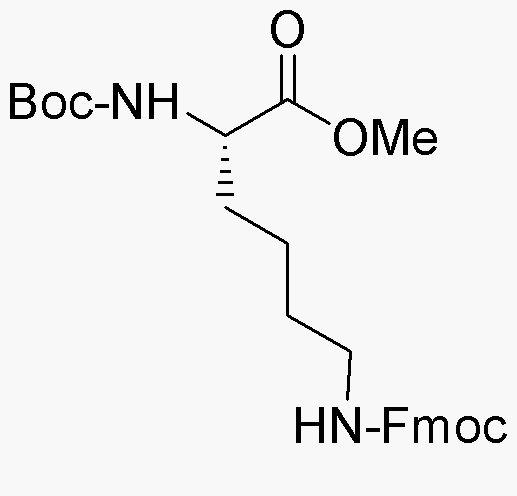Na-Boc-Ne-Fmoc-L-lysine methyl ester is widely utilized in research focused on:
- Peptide Synthesis: This compound serves as a key building block in the synthesis of peptides, particularly in solid-phase peptide synthesis, facilitating the creation of complex peptide sequences.
- Drug Development: It is used in the design of peptide-based therapeutics, offering advantages in stability and bioavailability, which are crucial for effective drug formulation.
- Bioconjugation: The compound is employed in bioconjugation strategies to attach peptides to other biomolecules, enhancing the specificity and efficacy of targeted therapies.
- Research in Protein Engineering: It plays a role in modifying lysine residues in proteins, allowing researchers to study protein interactions and functions more effectively.
- Diagnostic Applications: This chemical is also used in the development of diagnostic tools, such as peptide-based assays, which can improve the detection of various diseases.
General Information
Properties
Safety and Regulations
Applications
Na-Boc-Ne-Fmoc-L-lysine methyl ester is widely utilized in research focused on:
- Peptide Synthesis: This compound serves as a key building block in the synthesis of peptides, particularly in solid-phase peptide synthesis, facilitating the creation of complex peptide sequences.
- Drug Development: It is used in the design of peptide-based therapeutics, offering advantages in stability and bioavailability, which are crucial for effective drug formulation.
- Bioconjugation: The compound is employed in bioconjugation strategies to attach peptides to other biomolecules, enhancing the specificity and efficacy of targeted therapies.
- Research in Protein Engineering: It plays a role in modifying lysine residues in proteins, allowing researchers to study protein interactions and functions more effectively.
- Diagnostic Applications: This chemical is also used in the development of diagnostic tools, such as peptide-based assays, which can improve the detection of various diseases.
Documents
Safety Data Sheets (SDS)
The SDS provides comprehensive safety information on handling, storage, and disposal of the product.
Product Specification (PS)
The PS provides a comprehensive breakdown of the product’s properties, including chemical composition, physical state, purity, and storage requirements. It also details acceptable quality ranges and the product's intended applications.
Certificates of Analysis (COA)
Search for Certificates of Analysis (COA) by entering the products Lot Number. Lot and Batch Numbers can be found on a product’s label following the words ‘Lot’ or ‘Batch’.
*Catalog Number
*Lot Number
Certificates Of Origin (COO)
This COO confirms the country where the product was manufactured, and also details the materials and components used in it and whether it is derived from natural, synthetic, or other specific sources. This certificate may be required for customs, trade, and regulatory compliance.
*Catalog Number
*Lot Number
Safety Data Sheets (SDS)
The SDS provides comprehensive safety information on handling, storage, and disposal of the product.
DownloadProduct Specification (PS)
The PS provides a comprehensive breakdown of the product’s properties, including chemical composition, physical state, purity, and storage requirements. It also details acceptable quality ranges and the product's intended applications.
DownloadCertificates of Analysis (COA)
Search for Certificates of Analysis (COA) by entering the products Lot Number. Lot and Batch Numbers can be found on a product’s label following the words ‘Lot’ or ‘Batch’.
*Catalog Number
*Lot Number
Certificates Of Origin (COO)
This COO confirms the country where the product was manufactured, and also details the materials and components used in it and whether it is derived from natural, synthetic, or other specific sources. This certificate may be required for customs, trade, and regulatory compliance.


